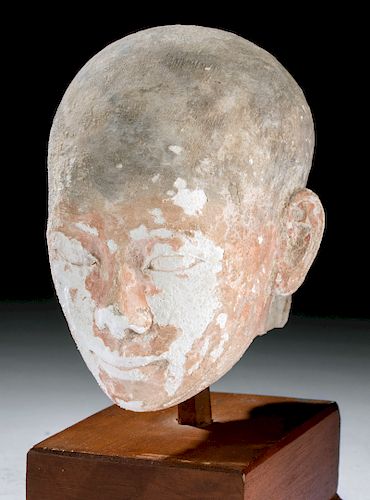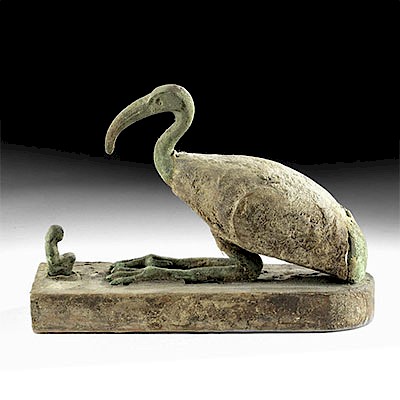Egyptian Gesso'd Limestone Sculptor's Model, ex-Mitry
Lot 5
About Seller
Artemis Fine Arts
686 S Taylor Ave, Ste 106
Louisville, CO 80027
United States
Selling antiquities, ancient and ethnographic art online since 1993, Artemis Gallery specializes in Classical Antiquities (Egyptian, Greek, Roman, Near Eastern), Asian, Pre-Columbian, African / Tribal / Oceanographic art. Our extensive inventory includes pottery, stone, metal, wood, glass and textil...Read more
Estimate:
$2,500 - $3,500
Absentee vs Live bid
Two ways to bid:
- Leave a max absentee bid and the platform will bid on your behalf up to your maximum bid during the live auction.
- Bid live during the auction and your bids will be submitted real-time to the auctioneer.
Bid Increments
| Price | Bid Increment |
|---|---|
| $0 | $25 |
| $300 | $50 |
| $1,000 | $100 |
| $2,000 | $250 |
| $5,000 | $500 |
| $10,000 | $1,000 |
| $20,000 | $2,500 |
| $50,000 | $5,000 |
| $100,000 | $10,000 |
| $200,000 | $20,000 |
About Auction
By Artemis Fine Arts
Oct 31, 2019
Set Reminder
2019-10-31 10:00:00
2019-10-31 10:00:00
America/New_York
Bidsquare
Bidsquare : Fine Antiquities, Asian, Ethnographic Art
https://www.bidsquare.com/auctions/artemis-gallery/fine-antiquities-asian-ethnographic-art-4581
Our Halloween Day auction features classical antiquities, ancient and ethnographic art from cultures encompassing the globe, plus fine art. Artemis Fine Arts info@artemisfinearts.com
Our Halloween Day auction features classical antiquities, ancient and ethnographic art from cultures encompassing the globe, plus fine art. Artemis Fine Arts info@artemisfinearts.com
- Lot Description
Egypt, Late Dynastic to Ptolemaic Period, ca. 664 to 30 BCE. A finely preserved and hand-carved limestone sculptor's model depicting the head of a youthful male, perhaps a scribe or priest based on the shaved head. The head presents with slender almond-shaped eyes and elongated canthi, a narrow, upturned nose with delineated nostrils, gently tapered cheeks, full lips with a grooved philtrum, a rounded chin, large ears of a veristic form, and a smooth, bald head with a slight peak just above the bridge of the nose. Ample traces of original dark-grey pigment for the hair as well as red-orange, flesh-toned pigment are visible across the face, ears, and verso. A fragmentary back pillar behind the neck suggests this represents an important personage as statuary models were typically reserved for those deemed to be of great significance by the pharaoh. Size: 2.875" W x 3.5" H (7.3 cm x 8.9 cm); 5.3" H (13.5 cm) on included custom stand.
A carved head like this example may have served as a model for a larger sculpture, to teach apprentice sculptors how to replicate a master style, or to produce ushabti figures (small funerary statues for tombs). Though sculptors' models are typically difficult to date - with some being from the Amarna period of the 18th Dynasty when new forms of statuary came in - most known examples are from the Late Dynastic and Ptolemaic periods. The Egyptians were keen observers of fauna, with many different animals gracing their mythology, artwork, and hieroglyphs; however, anthropomorphic models were typically among the most challenging to carve accurately.
While sculptors' models appear to be from larger composite figures, their incomplete presentation could be an entirely separate item typology. Ancient Greek sculptural incompleteness was a generic form of presentation as the viewer could extrapolate who or what a sculpture was meant to represent. In contrast, the ancient Egyptians would view an incomplete votive work of art only as it was: part of a bird, a disembodied head, or in one instance the hind quarters of a lion. According to Eric Young of the Metropolitan Museum of Art, "When we consider the Egyptian pieces as sculptors' models, however, their incompleteness is no longer disturbing, but entirely understandable. As is the case with unquestioned sculptors' models...the apprentice sculptor concentrated his energies on those portions of the figure that he found intriguing, or most difficult, and the master sculptor demonstrated the correct way to delineate a head…" ("Sculptors' Models or Votives? In Defense of a Scholarly Tradition." The Metropolitan Museum of Art Bulletin, March 1964, p. 255).
Provenance: private Orange County, California, USA collection; ex-Phillip Mitry collection, noted dealer in Cairo, Egypt until about 1951 when he emigrated to the United States
All items legal to buy/sell under U.S. Statute covering cultural patrimony Code 2600, CHAPTER 14, and are guaranteed to be as described or your money back.
A Certificate of Authenticity will accompany all winning bids.
We ship worldwide and handle all shipping in-house for your convenience.
#148210This is a fragment of a larger sculptural model. Losses to areas of neck and back pillar as shown. Minor nicks and chips to nose, ears, back pillar, and original pigmentation on face, with light fading to original pigment, and minor encrustations. Great traces of original pigment throughout. Drilled beneath neck for display purposes.Condition
- Shipping Info
-
All shipping is handled in-house for your convenience. Your invoice from Artemis Gallery will include shipping calculation instructions. If in doubt, please inquire BEFORE bidding for estimated shipping costs for individual items.
-
- Buyer's Premium



 EUR
EUR CAD
CAD AUD
AUD GBP
GBP MXN
MXN HKD
HKD CNY
CNY MYR
MYR SEK
SEK SGD
SGD CHF
CHF THB
THB














